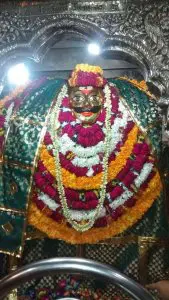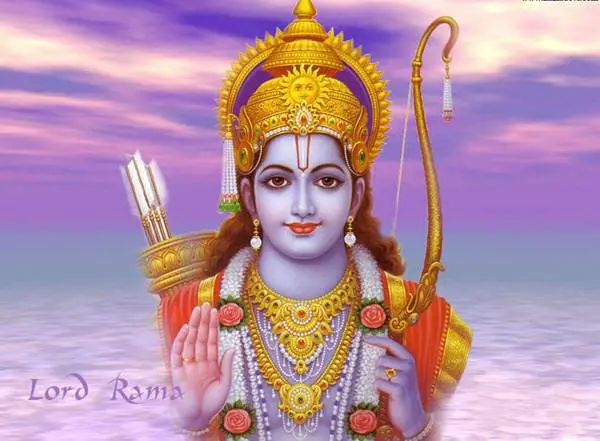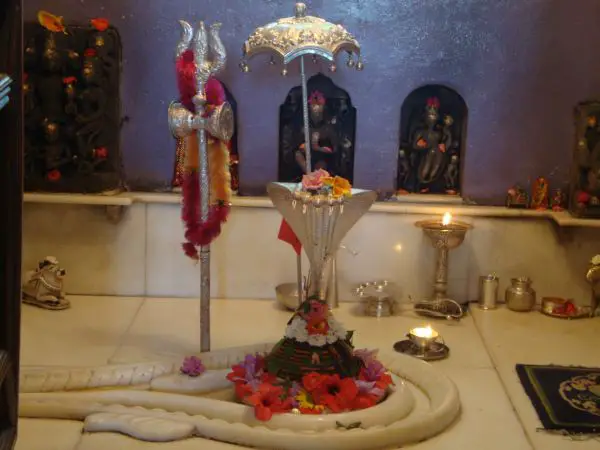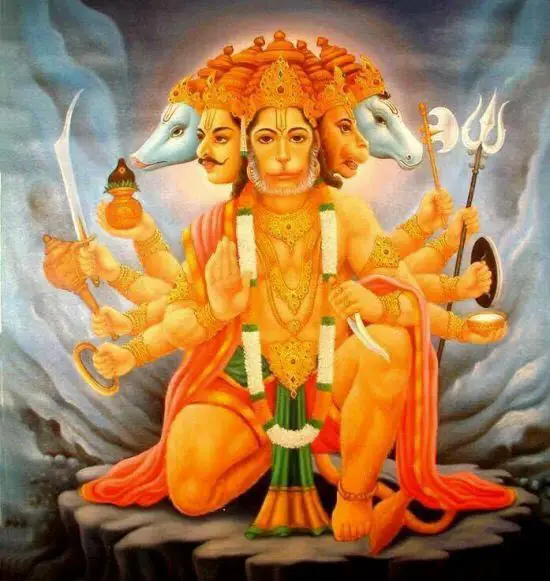Kaal Bhairava is regarded as a fierce manifestation of Lord Shiva, who is associated with annihilation. He is held sacred by the Hindus and is usually worshiped as a Hindu Tantric deity. This post is about Kaal Bhairava and Kalabhairava Mantra.
Table of Contents
About Kaal Bhairava
Hindus regard Kaal Bhairava as Supreme Reality. He is often known as Dandapani, the one who holds a rod or Danda for punishing sinners. He is also called Swaswa, meaning “whose horse is a dog.” He is worshiped throughout India as well as in Nepal, Sri Lanka, and Tibetan Buddhism.

In fact, Bhairava has its origin in the word “bhīru,” which means fearful. So, Bhairava means “terribly fearful form.” He is known as one who is beyond any fear. He is also the one who destroys fear and protects his devotees from dreadful enemies such as greed, lust, and anger.
According to another interpretation:
Bha stands for creation
Ra signifies sustenance
Va means destruction.
So, Bhairava means the one who creates, sustains, and dissolves the three stages of life. Therefore, Bhairava or Kaal Bhairava is regarded as the Ultimate or the Supreme God.
The origin of Bhairava or Kaal Bhairava has been recounted in the Shiva Mahapuran and can be traced to a conversation that was held between Brahma and Vishnu.
Once Vishnu asked Brahma, “Who is the Supreme Creator of this Universe?”
However, Brahma became arrogant and told Vishnu to worship him as the Supreme Creator. In fact, Brahma became so egoistic that he thought himself as Shiva. Moreover, he started to interfere with what Shiva was supposed to be doing.
Eventually, Lord Shiva decided to teach him (Brahma) a lesson. Consequently, Lord Shiva threw a small nail from his finger that took the form of Kaal Bhairava and cut off one of Brahma’s heads. Kalabhairava holds this skull of Brahma in his hand.
So, Brahma’s ego was destroyed, and he pleaded pardon from Lord Shiva. He was deeply grateful to Lord Shiva. It is further said that in the form of Kaal Bhairava, Shiva is guarding the Shaktipeethas (Shakti temples). Moreover, each Shaktipeethas has a temple which is dedicated to Kaal Bhairava.
There’s another popular belief which says that Lord Shiva himself created Kaal Bhairava. Once there was a demon named Dahurāsuraṇ who had a boon that he could be killed only by a woman. So, Goddess Parvati invoked her Shakti, Kali, for killing the demon.
Eventually, Kali was successful in killing the demon. However, her wrath continued, and it metamorphosed into a child.
Kali went on to feed the child with her milk. Lord Shiva then merged Kali and the child with him. It is said that from this merged form of Shiva, Bhairava came into being in eight forms known as Astanga Bhairava.
In this form, Bhairava is hailed as one of the sons of Shiva.
Puranas also give different versions of the emergence of Bhairava. According to one of these versions, once there was a war between the gods and the demons. In order to demolish the demons, Lord Shiva went on to create Kaal Bhairava from which the Astanga Bhairavas were formed. It is said that these Ashta Bhairavas went on to marry the Ashta Matrikas. They possessed very dreadful forms and created 64 Bhairavas and 64 Yoginis.
Usually, Kaal Bhairava is portrayed in a standing position and has four hands. He holds a drum, pasha (noose), trident, and skull. However, in some depictions, Kaal Bhairava is portrayed as having more than four hands.
He is shown without a dress and appears with a dog. His appearance is terrifying. He likes ghee bath, ghee lamp, honey, unbroken coconut, boiled food, red flowers, and fibrous fruits. It is said that worshiping him destroys enemies. Goddess Bhairavi is said to be the consort of Kaal Bhairava.
There are eight forms of Kalabhairava, known as Astanga Bhairavas. These Astha Bhairavas are said to control the eight directions of the Universe. They bless their devotees with eight types of wealth that represent Astha Lakshmi.
They are different in appearance and possess different weapons and different vehicles. There are separate mantras to please the eight Bhairavas. Each of these Astha Bhairavas has seven subs Bhairavas under him, thereby totaling 64 Bhairavas. All of these Bhairavas are ruled and controlled by Kaal Bhairava.
Kaal Bhairava is said to be the protector of the timid and women in general who are timid in nature. Worshiping Bhairava gives prosperity as well as success and good progeny. He prevents premature death and offers solutions to debts and liabilities.
All the different forms of Kaal Bhairava evolve from Lord Shiva, who is known as Maha Bhairava. He is ornamented with a range of twisted serpents that serve as earrings, anklets, bracelets as well as a sacred thread (Yagyopavita). He is shown wearing a tiger skin and an apron of human bones. His Vahana (vehicle) is a dog (Shvan).
The Ashta Bhairavas are as follows:
- Chanda Bhairava
- Ruru Bhairava
- Asithaanga Bhairava
- Kapaala Bhairava
- Krodha Bhairava
- Samhaara Bhairava
- Bheeshana Bhairava
- Unmattha Bhairava
Kaal Bhairava Mantra
It is said that Kaal Bhairava Sadhana helps you to get rid of all the negative aspects of your life. It protects you from evil forces and helps you to propel ahead in your career and business endeavors. Moreover, it grants you success in all your adventures.
It is useful for a happy and fulfilling life. Using Kaal Bhairava Mantra, you can easily do Kaal Bhairava Sadhana for pleasing him and getting his blessings. Here, we share with you some of the most popular Kalabhairava Mantra.
You need to recite these Mantras daily for getting the blessings of Kaal Bhairava. These Mantras have the power to eradicate all your problems and grant happiness to you and your family.
So, let’s get started:
- ॐ काल भैरवाय नमः
- ॐ भ्रां कालभैरवाय फट्
- ॐ क्रीं क्रीं कालभैरवाय फट
- ॐ श्री भैरवाय नमः
- ॐ हं षं नं गं कं सं खं महाकाल भैरवाय नम:
- ॐ ह्रीं बटुकाय आपदुद्धारणाय कुरु कुरु बटुकाय ह्रीं
- ॐ भयहरणं च भैरव:
- ओम ब्रह्म काल भैरवाय फट
- ॐ कर कलित कपाल कुण्डली दण्ड पाणी तरुण तिमिर व्याल यज्ञोपवीती कर्त्तु समया सपर्या विघ्न्नविच्छेद हेतवे जयती बटुक नाथ सिद्धि साधकानाम ॐ श्री बम् बटुक भैरवाय नमः
The most appropriate day to start Kaal Bhairava Sadhana is Sunday. However, Tuesday and Saturday are also considered equally good for starting Bhairava Upasana. As far as time is concerned, you should start the Mantra Jaap at midnight to get quick results.
You should face the eastern direction while doing Mantra Jaap. One needs to sit on a red-colored Asana and light a Chaturmukha Deepak of Sarso oil. You should offer Bhog to the Lord after completing the Jaap Sadhana. You should do an equal number of Mantra recitations each day at your convenience. One should recites Kaal Bhairava Mantra at least 108 times per day.
Kaal Bhairav Mandir, Varanasi
Kaal Bhairav Mandir is regarded as one of the oldest Shiva temples in Varanasi. This temple is dedicated to Kaal Bhairava, who is a fearful form of Lord Shiva. It wears a garland of skulls and carries a club which is made of peacock feathers.

This temple holds immense historical and cultural importance among the Hindus in general and especially amongst the locals. It is said that even death is afraid of Kaal Bhairava. This temple is located in Vishweshwarganj, Varanasi, and is very near to Kashi Vishwanath Temple.
It is believed that Kalabhairava decides who has to remain in Varanasi and who should not. People of Varanasi seek permission from the deity before leaving the city for any reason. According to popular belief, anyone who wants to visit Varanasi should first visit the temple and get permission from Kaal Bhairava to enter into Varanasi.
There is no charge or entry fee for the temple.
The temple is open from 5 am till 1:30 pm and from 4:30 pm till 9:30 pm.
The deity is visible from the entrance of the temple. Devotees buy sesame oil and red flowers for the deity. However, it is not mandatory. Moreover, unlike other temples, alcohol is offered to God. Here, the deity is portrayed with his celestial vehicle, dog. The exact date of the construction of this temple is not known. However, it is assumed to be in the 17th century.
History of Kaal Bhairava Mandir
Once Brahma and Vishnu had a quarrel as to who is the Supreme amongst the Trinity of Brahma, Vishnu, and Shiva. They laughed at the conclusion that Lord Shiva is the Supreme Power. This made Lord Shiva angry at Brahma and Vishnu. He went into a rage and created a ferocious light.
Lord Vishnu surrendered to this light; however, Brahma continued to stare at that light. It caused one of the heads of Brahma to burn out. This light transformed into being called Kaal Bhairava who walked around the world with the head of Brahma in his hand.
When he entered Varanasi (Kashi), the head dropped into the ground, and he got freed of his sins of Brahmahatya. Kaal Bhairava decided to stay back in Varanasi. He protects the devotees from all the problems.
So, that’s all in this post about Kaal Bhairav and Mantra. We hope that you found the post enriching and full of information. Thanks for visiting. We welcome your comments and suggestions.




